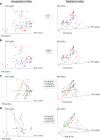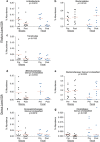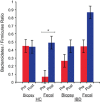The Effects of Bowel Preparation on Microbiota-Related Metrics Differ in Health and in Inflammatory Bowel Disease and for the Mucosal and Luminal Microbiota Compartments
- PMID: 26866392
- PMCID: PMC4817412
- DOI: 10.1038/ctg.2015.54
The Effects of Bowel Preparation on Microbiota-Related Metrics Differ in Health and in Inflammatory Bowel Disease and for the Mucosal and Luminal Microbiota Compartments
Abstract
Objectives: Bowel preparations (BPs) taken before colonoscopy may introduce a confounding effect on the results of gastrointestinal microbiota studies. This study aimed to determine the effect of bowel preparation on the mucosa-associated and luminal colonic microbiota in healthy subjects (HC) and inflammatory bowel disease (IBD) patients.
Methods: Biopsy samples (n=36) and fecal samples (n=30) were collected from 10 HC and 8 IBD subjects pre- and post-BP. 16S rRNA gene was pyrosequenced using 454 Titanium protocols. We compared the differences between the pre- and post-BP samples (i.e., comparisons-across-bowel-prep); we examined the effect of BP on the expected separation of the mucosal vs. the luminal compartments (i.e., comparisons-across-compartments). Last, we compared the baseline differences between the HC vs. IBD groups (a secondary analysis), and examined whether the differences between the HC vs. IBD changed after BP.
Results: In comparisons-across-bowel-prep, the Shannon's index (SI) decreased only in the biopsy samples of IBD subjects post-BP (P=0.025) and phylogenetic diversity-whole tree (PD-WT) metric decreased in biopsy samples of HC subjects post-BP (P=0.021). In secondary comparisons, the subtle differences between the fecal samples of the HC vs. IBD groups, in terms of evenness and the SI, were not apparent post-BP. In terms of β-diversity, in comparisons-across-bowel-prep, the proportion of shared operational taxonomic units (OTUs) in pre- and post-BP samples was low (~30%) and unweighted Unifrac distances between pre- and post-BP specimens ranged from 0.52 to 0.66. HC biopsies were affected more than IBD biopsies with BP (P=0.004). In comparisons-across-compartments, the proportion of shared OTUs between biopsy and fecal samples increased and Unifrac distances decreased post-BP in IBD subjects, reducing the differences between the mucosal and luminal compartments of the gut microbiota. Interindividual differences in Unifrac distances were preserved even with BP effects, although the effects were greater on weighted Unifrac distances. Bacteroidetes and its subtypes increased post-BP in both the luminal and mucosal compartments.
Conclusions: Bowel preparations affect the composition and diversity of the fecal and luminal microbiota in the short term, introducing potential bias into experiments examining the gut microbiota. The magnitude of the effect of BP is not greater than that of interindividual variation. Both the luminal and mucosal compartments of the gut microbiota get affected, and samples from controls and IBD subjects may get affected differently. Studies of the colonic microbiota should take into account the direction and the magnitude of the change introduced by BP during the design stage of the experiments, and consider sample sizes so that potential bias is minimized.
Figures








References
-
- Sears CL. A dynamic partnership: celebrating our gut flora. Anaerobe 2005; 11: 247–251. - PubMed
-
- Backhed F, Ley RE, Sonnenburg JL et al. Host–bacterial mutualism in the human intestine. Science (New York, NY) 2005; 307: 1915–1920. - PubMed
-
- Rajilic-Stojanovic M, Smidt H, de Vos WM. Diversity of the human gastrointestinal tract microbiota revisited. Environ Microbiol 2007; 9: 2125–2136. - PubMed
-
- Rappe MS, Giovannoni SJ. The uncultured microbial majority. Annu Rev Microbiol 2003; 57: 369–394. - PubMed
LinkOut - more resources
Full Text Sources
Other Literature Sources
Medical
Miscellaneous

